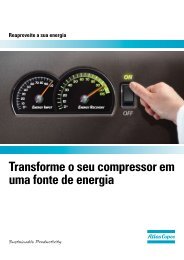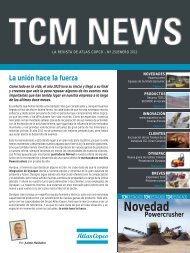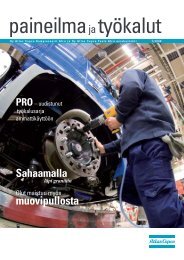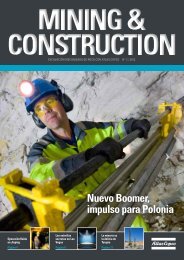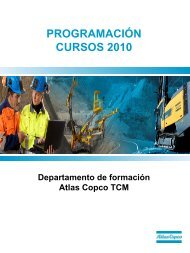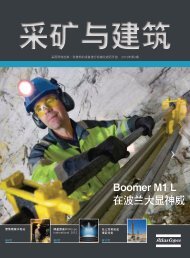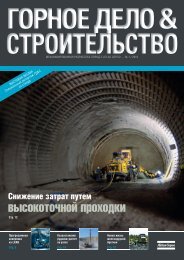World record for raiseboring - Atlas Copco
World record for raiseboring - Atlas Copco
World record for raiseboring - Atlas Copco
- No tags were found...
You also want an ePaper? Increase the reach of your titles
YUMPU automatically turns print PDFs into web optimized ePapers that Google loves.
<strong>Atlas</strong> <strong>Copco</strong>TEAMALLOY TM pipes at Mission Complex: The PV-271 drill runs with two, 7.6 m (25 ft) sections andone 2.4 m (8-ft ) section, 219 mm (18 5 /8") in diameter. Right, the Mission crew sets up the power supply <strong>for</strong> theelectric-powered version of the PV-271 which is used when time allows.says Mission driller Juan Salido. The electricdrill came with a larger compressor–74 m 3 /min (2 600 cfm) – whereas the dieselPit Viper has a 54 m 3 /min (1 900 cfm)compressor. Both average 8 000–10 000 mper month.Mine Manager Hal Galbraith says thediesel PV-271 works great <strong>for</strong> his mine.“I wouldn’t say we ran the tracks off therig, because we did haul it on our lowboytoo, but it went everywhere in the mine,”he says. Since then, the mine has focusedoperations to just two of the pits, but thediesel Pit Viper still moves to wherever it isneeded within the mining complex.Drill and blast manager Larry Maddoxnotes that the diesel rig offers a significantadvantage, working well at moving intotight spots on the bench to allow drillingto continue be<strong>for</strong>e power is moved into theworking area <strong>for</strong> the shovels.“Moving an electric drill just takes moretime compared to a diesel rig: having thecable crew available, cutting the power,moving the cable, planning the cable drops.You just can’t put a value on the mobilityyou get from a diesel drill,” he says.Salido adds: “It may only take 20 minutesto move the cable but 40 minutes or more<strong>for</strong> the crew to get there.”Anything that slows down a cable-movingcrew stops operations. For example, ifthe cable needs to be moved <strong>for</strong> an afternoonblast and the crew get a flat tire on thecable truck, everything would be held upuntil the tire could be changed.The diesel rig maximizes time spentdrilling. Softer rock at the mine may takeonly 20 to 30 minutes to drill each hole.However, other <strong>for</strong>mations that containmore garnet-tectite and wollastonite, mayrequire as much as two hours <strong>for</strong> the samehole requirements.Maddox says: “I think if you had plentyof time, electric would be better becauseof the cost to operate and maintain, butmobility more than makes up <strong>for</strong> it withthe diesel drill.”Comparing costsOne exception to this preference <strong>for</strong> diesel isthe operating cost. The electric drill currentlyoperates at 61 percent of the energy costs ofthe diesel drill and when diesel fuel edgedup to USD 4 per gallon (approx USD 1 perliter), the electric rig was more attractive.Galbraith lists some of the additional,indirect costs to be factored in with regardto an electric drill. Each electric rig requiresfour, 1 200 mm (4 000 ft) cables at USD100 000 each. A 138 kV–4160 V substationto power the drill costs USD 250 000.Additional manpower required to build theinfrastructure and to move the cable duringeach relocation must also be considered.Efficient drilling operations at Missionare the result of strategically matchingpipe and bits to these PV-271 rigs. TheTeamalloy pipe has a much higher costper piece price than other pipe, but itsdurability and longevity mean cost permeter is less in the long run.A 7.6 m (25 ft) section of Teamalloy pipelasts six weeks at Mission. Initial outsidedimension of the pipe is 220 mm (8.65").They will run it down to 203–200 mm (8 or7.9") be<strong>for</strong>e replacing it. The pipe shows itswear at the lower end of the joint, in whatoperators refer to as a “penciling” effect.They rotate these sections, since sectionscloser to the bit wear faster. This distributeswear evenly among the sections to increaselongevity overall.As <strong>for</strong> bits, the air-bearing type works thebest in this <strong>for</strong>mation with an average life <strong>for</strong>a bit at 2 300–2 440 m (7 500–8 000 ft). Eachdrill uses about two bits per week, dependingon the ground.Simple choiceFor Larry Maddox the choice is simple.“I want to keep them both,” he says.“Electric may be cheaper, but the mobilitywith diesel is better,” adding that eachhas characteristics that make the operationmore efficient and productive which, <strong>for</strong> thecompany, means greater profitability.Galbraith said the decision to buy this equipment<strong>for</strong> the drill and blast process is justifiedby the bottom line. He concludes: “For everydollar more you spend up front on drilling,you’ll make ten dollars on the back end.”12 MINING & CONSTRUCTION – 1 / 2011



